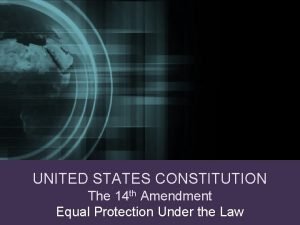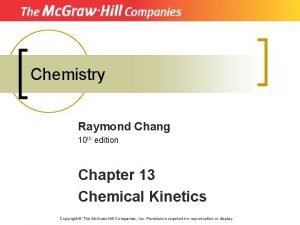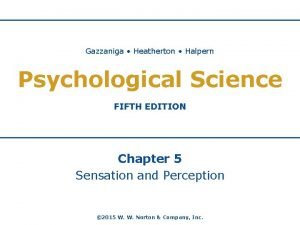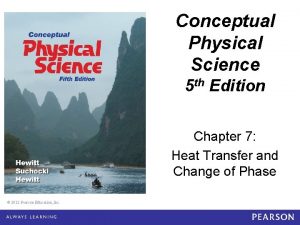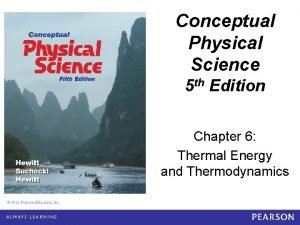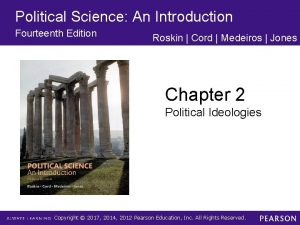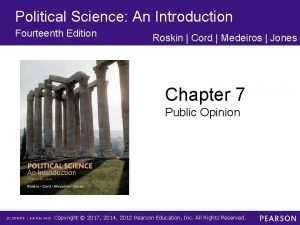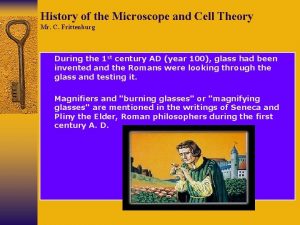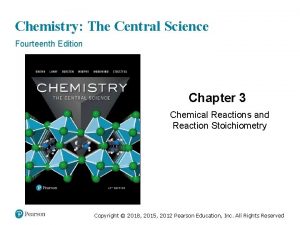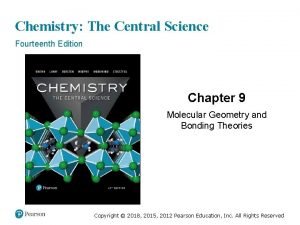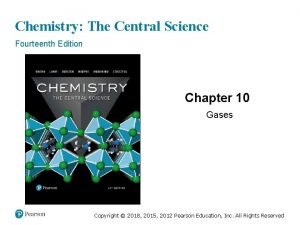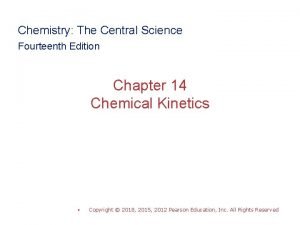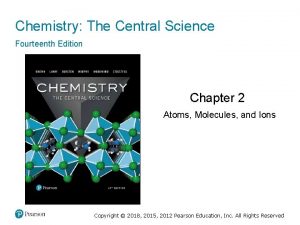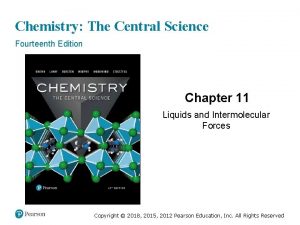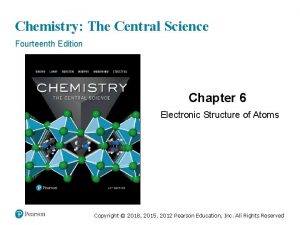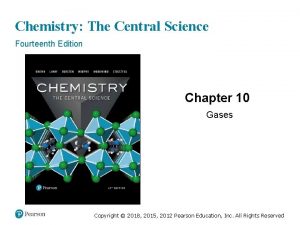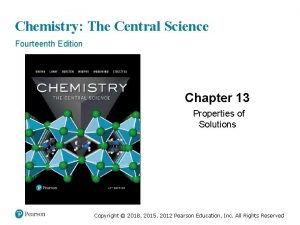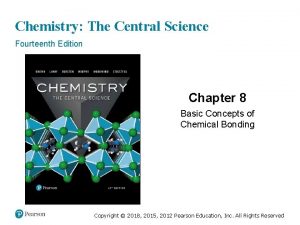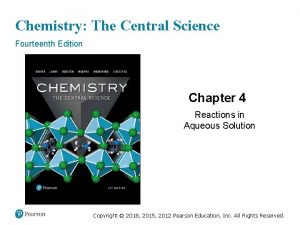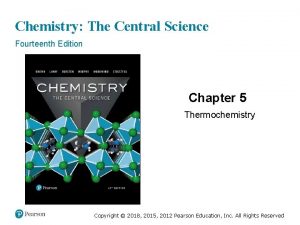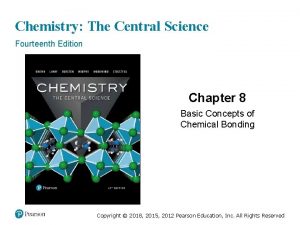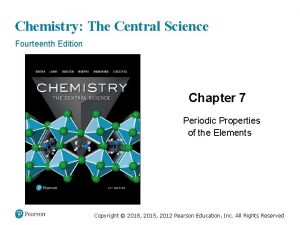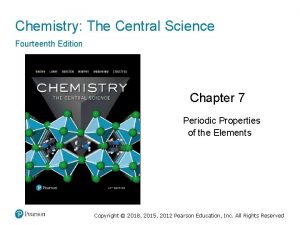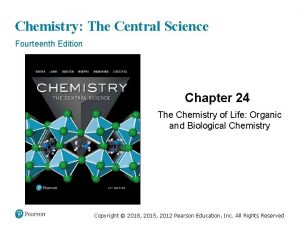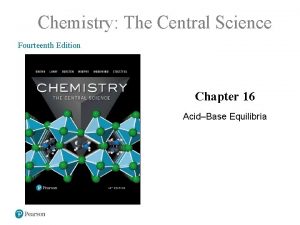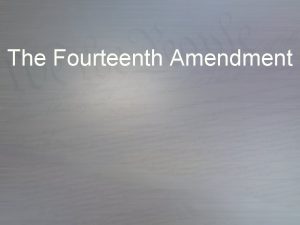Chemistry The Central Science Fourteenth Edition Chapter 19






















![Standard Entropies (3 of 3) [Table 19. 1 continued] S naught in joules per Standard Entropies (3 of 3) [Table 19. 1 continued] S naught in joules per](https://slidetodoc.com/presentation_image_h2/0da87b3d86962fc44a9b6a8e395f16c5/image-23.jpg)














- Slides: 37

Chemistry: The Central Science Fourteenth Edition Chapter 19 Chemical Thermodynamics Copyright © 2018, 2015, 2012 Pearson Education, Inc. All Rights Reserved

First Law of Thermodynamics • You will recall from Chapter 5 that energy cannot be created or destroyed. • Therefore, the total energy of the universe is a constant. • Energy can, however, be converted from one form to another or transferred from a system to the surroundings or vice versa. Copyright © 2018, 2015, 2012 Pearson Education, Inc. All Rights Reserved

Enthalpy/Entropy • Enthalpy is the heat absorbed by a system during a constant-pressure process. • Entropy is a measure of the randomness in a system. • Both play a role in determining whether a process is spontaneous. Copyright © 2018, 2015, 2012 Pearson Education, Inc. All Rights Reserved

Spontaneous Processes • Spontaneous processes proceed without any outside assistance. • Processes that are spontaneous in one direction are nonspontaneous in the reverse direction. • Don’t confuse spontaneous with fast. There are fast and slow reactions that are spontaneous. • Don’t confuse nonspontaneous with impossible. Energy can be used to make some reactions spontaneous that otherwise would not be. Copyright © 2018, 2015, 2012 Pearson Education, Inc. All Rights Reserved

Experimental Factors Affect Spontaneous Processes • Temperature and pressure can affect spontaneity. • An example of how temperature affects spontaneity is ice melting or freezing. Copyright © 2018, 2015, 2012 Pearson Education, Inc. All Rights Reserved

Reversible and Irreversible Processes (1 of 2) Reversible process: The system changes so that the system and surroundings can be returned to the original state by exactly reversing the process. This maximizes work done by a system on the surroundings. Copyright © 2018, 2015, 2012 Pearson Education, Inc. All Rights Reserved

Reversible and Irreversible Processes (2 of 2) Irreversible processes cannot be undone by exactly reversing the change to the system or cannot have the process exactly followed in reverse. Also, any spontaneous process is irreversible! Copyright © 2018, 2015, 2012 Pearson Education, Inc. All Rights Reserved

Entropy • Entropy can be thought of as a measure of the randomness of a system. • It is a state function: • It can be found by heat transfer from surroundings at a given temperature: Copyright © 2018, 2015, 2012 Pearson Education, Inc. All Rights Reserved

Second Law of Thermodynamics • The entropy of the universe increases in any spontaneous processes. • This results in the following relationships: Copyright © 2018, 2015, 2012 Pearson Education, Inc. All Rights Reserved

Entropy on the Molecular Scale (1 of 2) • Entropy on the molecular level (Boltzmann) • Gas molecule expansion: Two molecules start on one side above. What is the likelihood they end up there? • If one mole is used? Copyright © 2018, 2015, 2012 Pearson Education, Inc. All Rights Reserved

Entropy on the Molecular Scale (2 of 2) • Gases spontaneously expand to fill the volume given. • Most probable arrangement: approximately equal molecules in each side. Copyright © 2018, 2015, 2012 Pearson Education, Inc. All Rights Reserved

Statistical Thermodynamics • Thermodynamics looks at bulk properties of substances (the big picture). • We have seen what happens on the molecular scale. • How do they relate? • We use statistics (probability) to relate them. The field is called statistical thermodynamics. • Microstate: A single possible arrangement of position and kinetic energy of molecules Copyright © 2018, 2015, 2012 Pearson Education, Inc. All Rights Reserved

Boltzmann’s Use of Microstates • Because there are so many possible microstates, we can’t look at every picture. • W represents the number of microstates. • Entropy is a measure of how many microstates are associated with a particular macroscopic state. • The connection between the number of microstates and the entropy of the system is: Copyright © 2018, 2015, 2012 Pearson Education, Inc. All Rights Reserved

Entropy Change • Since entropy is a state function, the final value minus the initial value will give the overall change. • In this case, an increase in the number of microstates results in a positive entropy change (more disorder). Copyright © 2018, 2015, 2012 Pearson Education, Inc. All Rights Reserved

Effect of Volume and Temperature Change on the System • If we increase volume, there are more positions possible for the molecules. This results in more microstates, so increased entropy. • If we increase temperature, the average kinetic energy increases. This results in a greater distribution of molecular speeds. Therefore, there are more possible kinetic energy values, resulting in more microstates, increasing entropy. Copyright © 2018, 2015, 2012 Pearson Education, Inc. All Rights Reserved

Molecular Motions • Molecules exhibit several types of motion. – Translational: Movement of the entire molecule from one place to another – Vibrational: Periodic motion of atoms within a molecule – Rotational: Rotation of the molecule about an axis • Note: More atoms means more microstates (more possible molecular motions). Copyright © 2018, 2015, 2012 Pearson Education, Inc. All Rights Reserved

Entropy on the Molecular Scale • The number of microstates and, therefore, the entropy tend to increase with increases in – temperature. – volume. – the number of independently moving molecules. Copyright © 2018, 2015, 2012 Pearson Education, Inc. All Rights Reserved

Entropy and Physical States (1 of 2) • Entropy increases with the freedom of motion of molecules. • S(g) > S(l) > S(s) • Entropy of a system increases for processes where: – gases form from either solids or liquids. – liquids or solutions form from solids. – the number of gas molecules increases during a chemical reaction. Copyright © 2018, 2015, 2012 Pearson Education, Inc. All Rights Reserved

Entropy and Physical States (2 of 2) Copyright © 2018, 2015, 2012 Pearson Education, Inc. All Rights Reserved

Third Law of Thermodynamics • The entropy of a pure crystalline substance at absolute zero is 0. • Consider all atoms or molecules in the perfect lattice at 0 K; there will only be one microstate. Copyright © 2018, 2015, 2012 Pearson Education, Inc. All Rights Reserved

Standard Entropies (1 of 3) • The reference for entropy is 0 K, so the values for elements are not 0 J/mol K at 298 K. • Standard molar enthalpy for gases are generally greater than liquids and solids. (Be careful of size!) • Standard entropies increase with molar mass. • Standard entropies increase with number of atoms in a formula. (Remember: More microstates!) Copyright © 2018, 2015, 2012 Pearson Education, Inc. All Rights Reserved

Standard Entropies (2 of 3) Table 19. 1 Standard Molar Entropies of Selected Substances at 298 K S naught in joules per mole Kelvin Substance 130. 6 H 2 gas. 191. 5 N 2, gas 205. 0 O 2, gas H 2 O, gas 188. 8 N H 3, gas 192. 5 C H 3 O H, gas C 6 H 6, gas H 2 O, liquid C H 3 O H, liquid 237. 6 269. 2 69. 9 126. 8 Copyright © 2018, 2015, 2012 Pearson Education, Inc. All Rights Reserved
![Standard Entropies 3 of 3 Table 19 1 continued S naught in joules per Standard Entropies (3 of 3) [Table 19. 1 continued] S naught in joules per](https://slidetodoc.com/presentation_image_h2/0da87b3d86962fc44a9b6a8e395f16c5/image-23.jpg)
Standard Entropies (3 of 3) [Table 19. 1 continued] S naught in joules per mole Kelvin Substance C 6 H 6, liquid 172. 8 L I, solid 29. 1 N ay, solid 51. 4 64. 7 K, solid 27. 23 F e, solid. F e C l 3, solid N ay C l, solid 142. 3 72. 3 Copyright © 2018, 2015, 2012 Pearson Education, Inc. All Rights Reserved

Entropy Changes Entropy changes for a reaction can be calculated in a manner analogous to that by which H is calculated: where n and m are the coefficients in the balanced chemical equation. Copyright © 2018, 2015, 2012 Pearson Education, Inc. All Rights Reserved

Entropy Changes in Surroundings • Heat that flows into or out of the system changes the entropy of the surroundings. • For an isothermal process • At constant pressure, system. is simply H° for the Copyright © 2018, 2015, 2012 Pearson Education, Inc. All Rights Reserved

Entropy Change in the Universe • The universe is composed of the system and the surroundings. • Therefore, • For spontaneous processes Copyright © 2018, 2015, 2012 Pearson Education, Inc. All Rights Reserved

Total Entropy and Spontaneity • • Substitute for the entropy of the surroundings: – • Multiply by −T: – • Rearrange: – • Call – Copyright © 2018, 2015, 2012 Pearson Education, Inc. All Rights Reserved

Gibbs Free Energy 1) If G is negative, the forward reaction is spontaneous. 2) If G is 0, the system is at equilibrium. 3) If G is positive, the reaction is nonspontaneous, but spontaneous in the reverse direction. Copyright © 2018, 2015, 2012 Pearson Education, Inc. All Rights Reserved

Standard Free Energy Changes (1 of 2) Analogous to standard enthalpies of formation are standard free energies of formation, where n and m are the stoichiometric coefficients. Copyright © 2018, 2015, 2012 Pearson Education, Inc. All Rights Reserved

Standard Free Energy Changes (2 of 2) Table 19. 2 Conventions Used in Establishing Standard Free Energies State of Matter Standard State Solid Pure solid Liquid Pure liquid Gas 1 atm pressure Solution 1 M concentration Element for element in standard state Delta G naught of f = 0 Copyright © 2018, 2015, 2012 Pearson Education, Inc. All Rights Reserved

Free Energy Changes (1 of 2) Table 19. 3 How Signs of ΔH and ΔS Affect Reaction Spontaneity Delta H delta S negative T delta S delta G = delta H minus T delta S Reaction Characteristics Example − + − − Spontaneous at all temperatures 2 O 3, gas, yields 3 O 2, gas. + − + + Nonspontancous at all temperatures 3 O 2, gas, yields 2 O 3, gas − − + + or − Spontaneous at low T; nonspontaneous at high T H 2 O, liquid, yields H 2 O, solid + + − + or − Spontaneous at high T; nonspontaneous at low T H 2 O, solid, yields H 2 O, liquid. Copyright © 2018, 2015, 2012 Pearson Education, Inc. All Rights Reserved

Free Energy Changes (2 of 2) • How does ΔG change with temperature? • • Since reactions are spontaneous if ΔG < 0, the sign of enthalpy and entropy and the magnitude of the temperature matters to spontaneity. Copyright © 2018, 2015, 2012 Pearson Education, Inc. All Rights Reserved

Free Energy and Equilibrium (1 of 2) Under any conditions, standard or nonstandard, the free energy change can be found this way: (Under standard conditions, concentrations are 1 M, so Q = 1 and ln Q = 0; the last term drops out. ) Copyright © 2018, 2015, 2012 Pearson Education, Inc. All Rights Reserved

Free Energy and Equilibrium (2 of 2) • At equilibrium, Q = K, and G = 0. • The equation becomes • Rearranging, this becomes or Copyright © 2018, 2015, 2012 Pearson Education, Inc. All Rights Reserved

Coupling Reactions (1 of 2) • Many natural processes would NOT occur alone! • Nature couples them to offer the favorable energy conditions to cause something to occur, which is nonspontaneous alone. • Copyright © 2018, 2015, 2012 Pearson Education, Inc. All Rights Reserved

Coupling Reactions (2 of 2) Copyright © 2018, 2015, 2012 Pearson Education, Inc. All Rights Reserved

Copyright © 2018, 2015, 2012 Pearson Education, Inc. All Rights Reserved
 Management fourteenth edition
Management fourteenth edition The central science 14th edition
The central science 14th edition Fourteenth amendment
Fourteenth amendment Poem on summer season
Poem on summer season Thermodynamic vs kinetic control
Thermodynamic vs kinetic control Reaction of grignard reagent with acid chloride
Reaction of grignard reagent with acid chloride Halohydrin formation
Halohydrin formation What is a witches favourite subject in school
What is a witches favourite subject in school Mis chapter 6
Mis chapter 6 Chapter 1
Chapter 1 Organic chemistry david klein 3rd edition
Organic chemistry david klein 3rd edition Organic chemistry 2nd edition klein
Organic chemistry 2nd edition klein Introductory chemistry 4th edition
Introductory chemistry 4th edition Prefix multipliers
Prefix multipliers Introductory chemistry 5th edition answers
Introductory chemistry 5th edition answers Nomenclature of ethers
Nomenclature of ethers Zumdahl chemistry, 9th edition notes
Zumdahl chemistry, 9th edition notes Organic chemistry third edition david klein
Organic chemistry third edition david klein General chemistry
General chemistry Lesson 81 drop in molecular views answer key
Lesson 81 drop in molecular views answer key Chemistry by raymond chang 10th edition
Chemistry by raymond chang 10th edition Fifth edition chemistry a molecular approach
Fifth edition chemistry a molecular approach Organic chemistry 2nd edition klein
Organic chemistry 2nd edition klein Organic chemistry second edition david klein
Organic chemistry second edition david klein Ib organic chemistry functional groups
Ib organic chemistry functional groups Organic vs inorganic chemistry
Organic vs inorganic chemistry Biological science 6th edition
Biological science 6th edition Psychological science 5th edition
Psychological science 5th edition Conceptual physical science 5th edition
Conceptual physical science 5th edition Microscopic slush in water tends
Microscopic slush in water tends Conceptual physical science 5th edition
Conceptual physical science 5th edition The fundamentals of political science research 2nd edition
The fundamentals of political science research 2nd edition Political science 14th edition
Political science 14th edition Political science 14th edition
Political science 14th edition Science power 9 atlantic edition
Science power 9 atlantic edition Hát kết hợp bộ gõ cơ thể
Hát kết hợp bộ gõ cơ thể Frameset trong html5
Frameset trong html5 Bổ thể
Bổ thể


